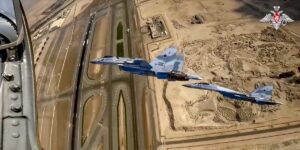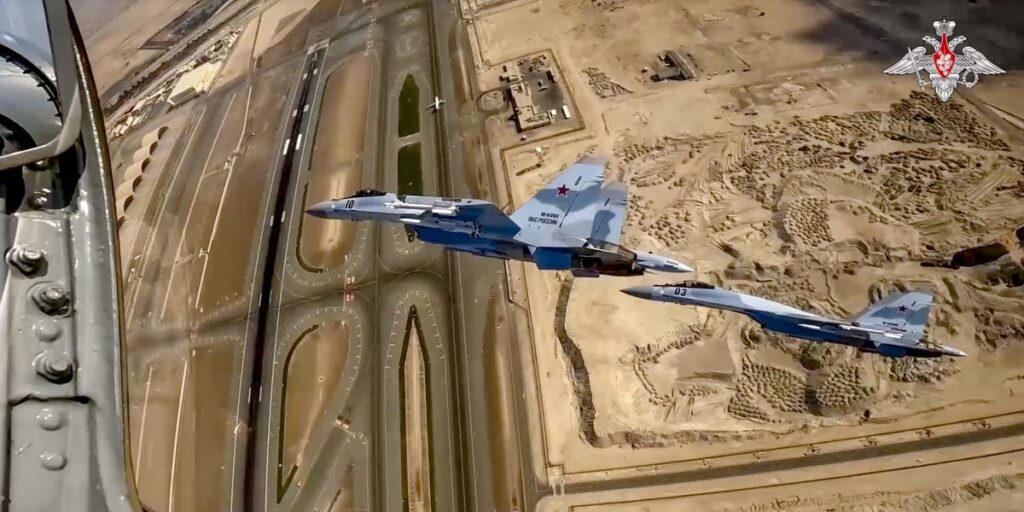- A regional expert believes Russia will supply Iran with Su-35 fighter jets.
- Advanced air defenses and anti-ship cruise missiles may also be on the table.
- These would bolster Iran’s power in the region at a critical moment.
Russia is considering deepening its military support for Iran and its regional militia allies with more advanced weapons that could worsen the confrontation between Iran and Israel. The drones and ballistic missiles Iran has supplied Russia for its Ukraine war may have been leverage to gain more powerful weapons in return: modern anti-ship missiles, advanced air defenses and the Su-35 Flanker air superiority fighter jet it has long-awaited.
Iran has ordered Su-35 fighters and also wants S-400 Triumf air defenses to, among other things, face Israel’s superior missiles and air force. If all these deals do go forward, they would enhance the military capabilities of Iran and its allied militias.
“Delivery of the Su-35S to Iran in any significant numbers will take time, as will training flight crews, maintainers, getting the required infrastructure and ground support equipment in place,” Justin Bronk, Senior Research Fellow for Airpower and Technology in the Military Sciences team at the United Kingdom’s Royal United Services Institute, told Business Insider.
“None of this is likely to be in a position to meaningfully affect Israeli strike plans in the immediate term,” Bronk said.
Israel has vowed to retaliate for the Iranian barrage of over 180 ballistic missiles against it on October 1. Since then, there was a dubious and unconfirmed claim in Iranian media that Russia has already delivered at least one squadron of Su-35s and an unspecified number of S-400s to Tehran.
Past claims of an imminent delivery of Su-35s in the Iranian press proved unfounded but there’s reason to believe Iran may actually get these capable, fourth-generation fighters sometime soon.
Anton Mardasov, a non-resident scholar with the Middle East Institute’s Syria program, believes the Su-35 deal is a “settled issue” since Russia already delivered Yak-130 trainer jets needed for training Iranian fighter pilots in September 2023.
The Su-35 would allow Iran to partially upgrade its antiquated air force, which hasn’t received new fighter jets since the early 1990s, and is likely to enhance its ability to defend its airspace. Even so, it’s unlikely to shift the balance of power in the region. The Arab Gulf monarchies still possess far more advanced combat aircraft than Iran. Consequently, drones and ballistic missiles will likely remain Tehran’s main means of projecting military power.
The Middle East Institute’s Mardasov told BI that the timing of the Su-35 delivery will most likely depend on “technical readiness” and other factors. He argued a timely delivery won’t necessarily be seen as a sign of strength for Iran but rather an indication that it cannot defend itself against Israeli strikes.
“It would look like an emergency delivery which will have a negative impact on Iran’s image, suggesting it is unable to parry the threat without Russian jets and other military assets,” Mardasov said.
In August, The New York Times reported Russia had begun delivering air defense hardware to Iran despite heightened tensions in the region after Israel assassinated a Hamas leader in Tehran. While the type of equipment was not specified, it could be the S-400 Iran has long sought.
Such deliveries could complicate Israeli or US airstrikes against Tehran. After Iran first directly attacked Israel in April with a drone and missile barrage, Israel responded by destroying the radar of one of Iran’s S-300PMU-2s, Iran’s most advanced air defense system acquired from Russia and the S-400’s predecessor.
Mardasov does not believe Moscow will supply Tehran with the more advanced S-400, pointing out that Russia’s own air defenses are strained from its war on Ukraine. Russia needs all the air defenses it can muster to defend its ammo depots from waves of Ukrainian drone attacks and enable its air force to provide supporting strikes for its troops in Ukraine.
Even if Russia decided to supply Iran with the S-400, the training program would take around five months, meaning Iran would not get them online until next spring at the earliest.
A P-800 missile deal may be especially provocative. Russia is reportedly discussing supplying this anti-ship cruise missile to the Houthis. The P-800 boasts an 186-mile range and can skim the sea’s surface en route. They are more advanced than other anti-ship missiles in the rebel group’s arsenal, and would fuel their dangerous attacks on commercial ships and the US-led coalition defending them. Russian intelligence operatives have reportedly advised the Houthis in their attacks against commercial ships.
Iran is reportedly brokering the deal, while Yemen’s northern neighbor Saudi Arabia and the United States oppose it. Russian President Vladimir Putin has already suggested Russia might arm Western adversaries under certain circumstances.
“As for the anti-ship missiles, I think that if the talks between Moscow and the Houthis were really about supplying missiles, they were of a general nature,” Mardasov said. “Although I think it was more a deliberate leak involving Russian intelligence services to back up Putin’s words about possibly arming America’s adversaries.”
The Russian president warned in June that Moscow could arm enemies of the West in response to their arming Ukraine and authorizing Kyiv to use Western munitions for limited strikes inside Russia, affirming that “we reserve the right to act the same way.”
The Russia analyst is skeptical that any direct transfer will take place, noting that it could put Chinese-owned tankers at risk. A Houthi missile already hit the Chinese-owned MV Huang Pu tanker, which was flying a Panamanian flag, earlier this year.
“In addition, such a deliberate delivery of missiles would greatly irritate Arab countries, which are important partners for Moscow in the current sanctions environment,” Mardasov said.
Nevertheless, he sees a scenario where these missiles could find their way to the Houthis “allegedly by accident via Syria,” if the US and its allies were to authorize Ukraine to use Western-made ATACMS missiles against Russia.
Such a scenario already appears to have happened with Iran’s main militia proxy, Hezbollah in Lebanon, which acquired the export variant of the P-800, the Yakhont, in Syria under unclear circumstances.
Read the full article here
















